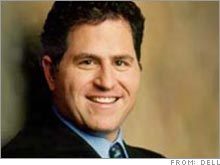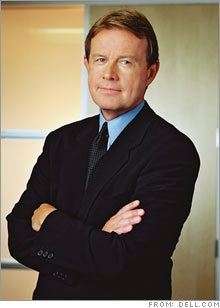Uh... maybe I should driveIt's been a rough year in Round Rock, Texas. Inside Michael Dell's campaign to repair the company he founded.(Fortune Magazine) -- The limo ride from the Shanghai Four Seasons to Dell's China headquarters should take about half an hour. At the rate Michael Dell is traveling - with a honking police escort and a driver unafraid to cross the center line - we'll be there in ten minutes. That's the kind of special treatment Dell gets in the People's Republic. He flew in last night from India; tonight he leaves for Japan. He does this Asia swing at least twice a year - meeting customers, leading town meetings with employees - and it's obvious that he digs it: the boom-boom schedule, the standing ovations, the fawning questions in halting English that begin with "You are a like a legend." "What's not to like?" he says, swiveling that big square head of his (now with a dusting of gray at the temples and the nape of the neck - hey, he just turned 42), flashing that sheepish grin. "It's a good time."
And a welcome distraction. Not for the first time in its rapid march from student startup to the upper reaches of the Fortune 500 (this year No. 34), Dell (Charts), the company, is in a funk. Yes, yes, it's all relative. This titan with $57 billion in revenues remains profitable; its cash flow from operations during the fourth quarter of 2006 alone was more than $1 billion. ("I like to remind people," says new Dell CFO, and former American Airlines CEO, Don Carty, "that companies generating $1 billion cash per quarter don't need as much turnaround as some other businesses I've seen.") That said, in the same fourth quarter Dell surrendered the glory belt of worldwide PC sales champion to archrival Hewlett-Packard (Charts). The current score, according to IDC, is HP 18%, Dell 15%. Hardly a tragedy by itself - that belt goes back and forth - but humiliating, and a fitting symbol for a year nobody at Dell, least of all the boss, is proud of. After emerging from the tech bust into four straight years of double-digit expansion, Dell hit a wall in 2006. Revenue growth stalled, profits fell by more than a quarter, and its operating margin, which had been hovering well above HP's, returned to earth. What's worst, HP stock soared 45% last year, against a 16% decline for Dell, a trend that carried over into this year. Consequently we have a little shakeup at Dell - new faces, new ideas, and a renewed commitment from the newly reinstated CEO. Dell dearly wants his company to be the No. 1 PC manufacturer in the world again. But the bigger challenge is reigniting growth, and doing that will require bountiful creativity from an organization not known for creative leaps. It will also require a different style of leadership from what stolid, relentless Michael Dell has exhibited in the past. "Obviously I feel an enormous responsibility - to our people, our company, our shareholders," Dell says, with appropriate swagger and resolve, an open can of MET-Rx Protein Plus in his fist. "And it's my name. So we're going to make this work. Period. Full stop." The overhaul began late last year with the hiring of Carty, a longtime board member. Among his tasks: to shepherd Dell through a continuing SEC investigation, about which little is known beyond the disturbing news, announced March 29, that Dell would miss two April filing deadlines following the discovery of "a number of accounting errors, evidence of misconduct, and deficiencies in the financial-control environment." With Carty came Steve Schuckenbrock from EDS (Charts) to run and grow Dell's services division - a $6 billion business. Then, in early February, two other high-profile hires arrived: Ron Garriques, a product guy from Motorola (Charts), whose daunting task is to transform the consummate box-builder into a cool consumer brand, and Mike Cannon, who quit as CEO at Solectron to become Dell's first-ever global operations chief. (That's right, Cannon and Carty make two former Fortune 500 CEOs who now have to laugh at another CEO's jokes.) Dell guaranteed each $12 million in severance if they don't make it through the first year. "For a guy who's known to be frugal," says independent tech analyst Rob Enderle, "it appeared that price is no object." Even as Cannon and Garriques were coming onboard, CEO Kevin Rollins, Dell's chosen successor, was leaving. (His severance: $5 million.) "I don't think [Dell] wanted to fire Kevin," says Dell's friend Marc Benioff, CEO of Salesforce.com (Charts). "I think he was okay, even six months ago, with what the structure was. But things just disintegrated too quickly." Dell doesn't want to talk about any of that beyond acknowledging, in a published report, that he personally urged the board to make the switch. "Kevin is my friend," he tells Fortune. "We had 13 years together, and the company grew from $5 billion to $56 billion, and he deserves a lot of the credit. But it was time to make a change. And we made the change, and we're moving on." (Rollins, who remains on the Dell payroll through May 4, declined through a spokesman to comment.) The keystone in this new construction, of course, is Dell himself, who kept the chairman's title all along but now is CEO again. The return of the founding hero is a familiar plot line in business and history, though its significance is sometimes misinterpreted. Too often we assume it's about "preaching a lost religion," says Jeffrey Sonnenfeld, a professor at the Yale School of Management and author of "The Hero's Farewell: What Happens When CEOs Retire." Back to basics and all that. "If it's driven by vanity," Sonnenfeld agrees, "that can be the case." But there is another way it can go. As examples, Sonnenfeld cites Apple's (Charts) Steve Jobs in 1997 and Charles Schwab in 2004. "They came back in to falsify the previous model," he says. "To revisit, revolutionize, the model that they had invented. They didn't see it as a loss of credibility to challenge it and adjust to new circumstances." That's where Michael Dell is now - "working harder," the CEO says, "having a great time," and discovering "latent energy that I wasn't using before." The model he invented - and means to revolutionize - is "Dell Direct," meaning direct contact with every customer, via telephone, Internet, or Dell's in-house sales force, and every computer built to order. It was a powerful differentiator for many years, fueling extraordinary growth and attracting delegations of admirers from all over the world to Dell's Round Rock, Texas, campus. But it's less of an advantage now as computer hardware becomes ever more a commodity, squeezing margins ever tighter. "The thing I've been saying internally is," Dell says, borrowing Sonnenfeld's metaphor, "the direct model is not a religion. It's a great strategy, works well; there are things we can do with it. But that's not the only thing we can do as a company." To wit, Dell envisions huge new opportunities to take on IBM (Charts), among others, in selling software and services, especially to big corporate customers already buying Dell servers and desktops. He sees openings in mobile computing, including cellphones, PDAs, and consumer-friendly laptops. And he has a hungry eye on the "next billion customers" coming online in developing markets such as China, India, and Eastern Europe. In fact, that's the main reason he's in Shanghai - to introduce the EC 280, a low-cost desktop designed in Dell's China Design Center. |
Sponsors
|



